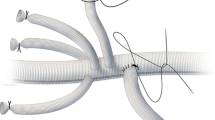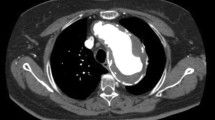Abstract
The incidence of spinal cord injury in thoracic endovascular aortic repair (TEVAR) has been 3–5 % from recent major papers where sacrifice of the critical intercostal arteries is inevitable by a stent graft. Hemodynamic stability, which depends on a network of blood vessels around the cord is most important not only during but also after stent-graft deployment. High risk factors of spinal cord injury during endovascular aortic repair are (1) coverage of the left subclavian artery, (2) extensive coverage of long segments of the thoracic aorta, (3) prior downstream aortic repair, (4) compromising important intercostal (T8–L1), vertebral, pelvic and hypogastric collaterals, and (5) shaggy aorta. Preoperative, intraoperative, and postoperative managements have been required to prevent spinal cord injury with TEVAR. For imaging assessment of blood supply to spinal cord including Adamkiewicz artery, prophylactic cerebrospinal fluid drainage is mandatory, and monitoring motor-evoked potential is recommended for high risk factors of spinal cord injury. Mean arterial pressure should be maintained over 90 mmHg after stent-graft placement for a while to prevent delayed spinal cord ischemia in high-risk patients of spinal cord ischemia. Finally, because spinal cord injury during TEVAR is not rare and negligible, perioperative care during TEVAR should be strictly performed according to the protocol proposed by each cardiovascular team.



Similar content being viewed by others
References
Leurs LJ, Bell R, Degrieck Y, Thomas S, Hobo R, Lundbom J. Endovascular treatment of thoracic aortic diseases: combined experience from the EUROSTAR and United Kingdom Thoracic Endograft registries. J Vasc Surg. 2004;40:670–9.
Chiesa R, Melissano G, Marrocco-Trischitta MM, Civilini E, Setacci F. Spinal cord ischemia after elective stent-graft repair of the thoracic aorta. J Vasc Surg. 2005;42:11–7.
Makaroun MS, Dillavou ED, Kee ST, Sicard G, Chaikof E, Bavaria J, et al. Endovascular treatment of thoracic aortic aneurysms: results of the phase II multicenter trial of the GORE TAG thoracic endoprosthesis. J Vasc Surg. 2005;41:1–9.
Estrera AL, Sheinbaum R, Miller CC, Azizzadeh A, Walkes JC, Lee TY, et al. Cerebrospinal fluid drainage during thoracic aortic repair: safety and current management. Ann Thorac Surg. 2009;88:9–15.
Preventza O, Wheatley GH 3rd, Williams J, Ramaiah V, Rodriguez-Lopez J, Diethrich EB. Identifying paraplegia risk associated with thoracic endografting. Asian Cardiovasc Thorac Ann. 2009;17:568–72.
Khoynezhad A, Donayre CE, Bui H, Kopchok GE, Walot I, White RA. Risk factors of neurologic deficit after thoracic aortic endografting. Ann Thorac Surg. 2007;83:S882–9.
Buth J, Harris PL, Hobo R, van Eps R, Cuypers P, Duijm L, et al. Neurologic complications associated with endovascular repair of thoracic aortic pathology: Incidence and risk factors. A study from the European Collaborators on Stent/Graft Techniques for Aortic Aneurysm Repair (EUROSTAR) registry. J Vasc Surg. 2007;46:1103–10 (discussion 1110–1).
Feezor RJ, Martin TD, Hess PJ Jr, Daniels MJ, Beaver TM, Klodell CT, et al. Extent of aortic coverage and incidence of spinal cord ischemia after thoracic endovascular aneurysm repair. Ann Thorac Surg. 2008;86:1809–14 (discussion 1814).
Amabile P, Grisoli D, Giorgi R, Bartoli JM, Piquet P. Incidence and determinants of spinal cord ischaemia in stent-graft repair of the thoracic aorta. Eur J Vasc Endovasc Surg. 2008;35:455–61.
Cheng D, Martin J, Shennib H, Dunning J, Muneretto C, Schueler S, et al. Endovascular aortic repair versus open surgical repair for descending thoracic aortic disease a systematic review and meta-analysis of comparative studies. J Am Coll Cardiol. 2010;55:986–1001.
Rizvi AZ, Murad MH, Fairman RM, Erwin PJ, Montori VM. The effect of left subclavian artery coverage on morbidity and mortality in patients undergoing endovascular thoracic aortic interventions: a systematic review and meta-analysis. J Vasc Surg. 2009;50:1159–69.
Cheung AT, Pochettino A, McGarvey ML, Appoo JJ, Fairman RM, Carpenter JP, et al. Strategies to manage paraplegia risk after endovascular stent repair of descending thoracic aortic aneurysms. Ann Thorac Surg. 2005;80:1280–8 (discussion 1288–9).
Weigang E, Hartert M, Siegenthaler MP, Beckmann NA, Sircar R, Szabo G, et al. Perioperative management to improve neurologic outcome in thoracic or thoracoabdominal aortic stent-grafting. Ann Thorac Surg. 2006;82:1679–87.
Hnath JC, Mehta M, Taggert JB, Sternbach Y, Roddy SP, Kreienberg PB, et al. Strategies to improve spinal cord ischemia in endovascular thoracic aortic repair: outcomes of a prospective cerebrospinal fluid drainage protocol. J Vasc Surg. 2008;48:836–40.
Rizvi AZ, Sullivan TM. Incidence, prevention, and management in spinal cord protection during TEVAR. J Vasc Surg. 2010;52:86S–90S.
Matsuda H, Fukuda T, Iritani O, Nakazawa T, Tanaka H, Sasaki H, Minatoya K, Ogino H. Spinal cord injury is not negligible after TEVAR for lower descending aorta. Eur J Vasc Endovasc Surg. 2010;39(2):179–86.
Ullery BW, Cheung AT, Fairman RM, Jackson BM, Woo EY, Bavaria J, Pochettino A, Wang GJ. Risk factors, outcomes, and clinical manifestations of spinal cord ischemia following thoracic endovascular aortic repair. J Vasc Surg. 2011;54(3):677–84.
Bicknell CD, Riga CV, Wolfe JHN. Prevention of paraplegia during thoracoabdominal aortic aneurysm repair. Management and prevention of paraplegia during and after Thoracic Aortic stenting and hybrid repair. Eur J Vasc Endovasc Surg. 2009;37:654–60.
DeSart K, Scali ST, Feezor RJ, Hong M, Hess PJ, Beaver TM, et al. Fate of patients with spinal cord ischemia complicating thoracic endovascular aortic repair. J Vasc Surg. 2013;58:635–42.
Wong CS, Healy DH, Canning C, Coffey JC, Boyle JR, Walsh SR. A systemic review of spinal cord injury and cerebrospinal fluid drainage after thoracic endografting. J Vasc Surg. 2012;56:1438–47.
Okita Y. Fighting spinal cord complication during surgery for thoracoabdominal aortic disease. Gen Thorac Cardiovasc Surg. 2011;59(2):79–90.
Martin DJ, Martin TD, Hess PJ, Daniels MJ, Feezor RJ, Lee WA. Spinal cord ischemia after TEVAR in patients with abdominal aortic aneurysms. J Vasc Surg. 2009;49:302–6.
Uchida N. Open stent grafting for complex diseases of the thoracic aorta: clinical utility. Gen Thorac Cardiovasc Surg. 2013;61:118–26.
McNally MM, Aqle SC, Parker FM, Boqey WM, Powell CS, Stoner MC. Preoperative statin therapy is associated with improved outcomes and resource utilization in patients undergoing aortic aneurysm repair. J Vasc Surg. 2010;51:1390–6.
Rizvi AZ, Murad MH, Fairman RM, Erwin PJ, Montori VM. The effect of left subclavian artery coverage on morbidity and mortality in patients undergoing endovascular thoracic aortic interventions: a systematic review and meta-analysis. J Vasc Surg. 2009;50:1159–69.
Schurink GWH, Nijenhuis RJ, Backes WH, Mess W, de Haan MW, Mochtar B, Jacobs MJ. Assessment of spinal cord circulation and function in endovascular treatment of thoracic aortic aneurysms. Ann Thorac Surg. 2007;83:S877–81.
Skuzawa S, Mitsuoka H, Ishigami N, Suzuki K. An experience of distal embolic protection with a filtered temporary AV shunt during TEVAR for shaggy aorta. Jpn J Vasc Surg. 2013;22:1009–12.
Conflict of interest
The author has declared that no conflict of interest exists.
Author information
Authors and Affiliations
Corresponding author
Additional information
This review was submitted at the invitation of the editorial committee.
Rights and permissions
About this article
Cite this article
Uchida, N. How to prevent spinal cord injury during endovascular repair of thoracic aortic disease. Gen Thorac Cardiovasc Surg 62, 391–397 (2014). https://doi.org/10.1007/s11748-014-0395-9
Received:
Published:
Issue Date:
DOI: https://doi.org/10.1007/s11748-014-0395-9




